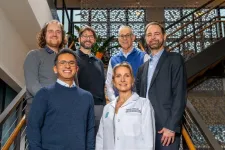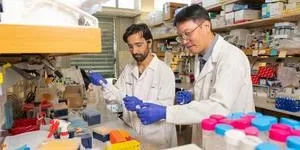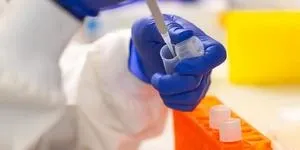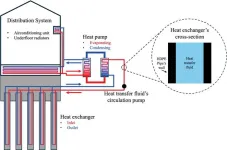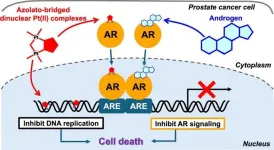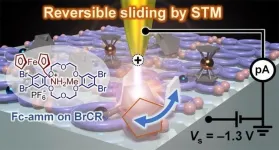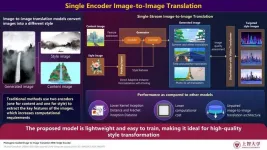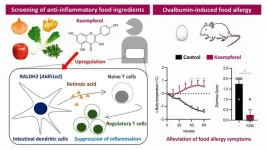Collaborative asthma project between Brigham and Women’s Hospital and the Wyss Institute advances with new grant support
New industry support enables the team to expand their search and validation of diagnostic biomarkers to shed light on asthma with thus far unexplained causes and improve therapy
By Benjamin Boettner
(BOSTON) – Asthma affects more than 260M people worldwide and nearly 28M people in the U.S. alone, where, on average, 10 people die from attacks of the chronic disease each day. Many of these deaths could be prevented if patients had timely access to the appropriate therapy following an accurate diagnosis.
Driven by an acute sense of urgency to close this diagnostic gap, a research collaboration between clinical immunologist Tanya Laidlaw, M.D. at Brigham and Women’s Hospital (BWH) in Boston and Rushdy Ahmad, Ph.D., Director of the Diagnostics Accelerator (DxA) at the Wyss Institute at Harvard University set out to shed new light on causes of asthma that defy known categories and thus far remain unexplained and thus untreatable and to eventually pave the way towards a diagnostic test that is able to distinguish between different forms of asthma. The team has now received a grant from Sanofi that will allow them to expand upon an initial set of distinguishing protein biomarkers identified in a pilot study across a significantly larger patient cohort.
Many of us have experienced with friends or family, or even ourselves the alarming symptoms of asthma: the typical trouble breathing, wheezing, coughing, and tightness or pain in the chest. However, asthma can have very different inflammatory causes that must be differently treated in order to help or even rescue patients. “Being able to precisely pinpoint the type of asthma a patient is suffering from with a simple yet highly specific test remains a critical unmet need in respiratory medicine. Clear results that can distinguish different types of asthma would also greatly improve treatment courses and potentially lead to new ones,” said Laidlaw. “I am thrilled about the opportunities that have opened up now thanks to the Wyss DxA’s exceptional capabilities and organization, and to the grant support from Sanofi which will allow us to take our studies to the next level.” Laidlaw is the Director of Translational Research at BWH’s Division of Allergy and Clinical Immunology, and Associate Professor at Harvard Medical School (HMS).
To dramatically accelerate the development of next-generation diagnostics, the Wyss DxA takes its cues directly from clinicians from the clinical community at the BWH in Boston, such as Laidlaw, who experience the lack of diagnostic capabilities first-hand and can provide deep insights into patients’ histories and diseases. Fortified with this knowledge, and with access to high-quality patient samples, the Wyss DxA then brings its capabilities to bear on the problems at hand. In the asthma project, the Wyss DxA’s Biomarker Discovery Laboratory (BDL) played a crucial role, as the lack of specific molecular biomarkers for asthma and other underexplored diseases has hindered the development of clinical diagnostic tests. “Our asthma-focused partnership with Dr. Laidlaw maximizes our combined strengths in advanced biomarker discovery and clinical validation, aiming to establish a new translational pathway that will accelerate the development of a critically needed diagnostic test,” said Ahmad, who conceptualized the project with Laidlaw. Ahmad coordinates all of the Wyss DxA’s collaborations with clinicians at BWH in close partnership with James (Trey) Toombs, Ph.D., Program Director at the BWH, and Head of Operations of the Wyss DxA’s Industrial Participant Program (IPP).
Asthma intricacies
Clinical asthma researchers have started to embrace the concept of “endotyping” to classify patients’ asthma disease into distinct subtypes based on their underlying molecular features, but they need more help to do this efficiently. Asthma often is associated with a type of inflammation in the lungs that is known as type 2 inflammation (T2-high), which the immune system may have originally evolved to fight pathogens but that can also go into overdrive to trigger asthmatic and allergic conditions. Typically, patients with T2-high asthma exhibit increased numbers of an immune cell called eosinophils and/or increased levels of the antibody immunoglobulin E (IgE) in their blood. Both of these can be clinically measured in blood samples with the caveats that high eosinophils and IgE levels in patients’ blood can occur independent of processes taking place in their lungs, and that elevated IgE and eosinophil levels can also occur in patients who do not have asthma.
Importantly, the two broader groups of available asthma drugs work by lowering either eosinophils or IgE, or the type 2 inflammatory pathways leading to their production. However, there remains a significant number of asthma patients who, despite being T2-high and having increased numbers of eosinophils and/or IgE levels, don’t respond to the available therapies, as well as asthma patients who lack type 2 inflammation (T2-low) altogether and therefore do not exhibit abnormally high levels of eosinophils or IgE. This led asthma researchers to the realization that another type of inflammation must be at work that cannot be therapeutically targeted yet.
“In reality, asthma is a very heterogenous condition and, thus far, we don’t have the diagnostic means to quickly determine which patients develop asthma symptoms because of inflammation in their lungs that is different from type 2 inflammation and might require new therapies,” said Laidlaw. “Being able to easily and accurately ‘fingerprint’ different forms of asthma based on different biomarker signatures would dramatically improve the treatment course doctors could prescribe to many of their asthma patients,” said Laidlaw.
The power of biomarkers
After Laidlaw had proposed the diagnostic asthma challenge, the strategic plan laid out by her and Ahmad first sought to address the problem in a pilot study. Bringing further attention to the matter and their collaborative effort, Laidlaw, in 2023, also discussed the critical need for biomarkers that can immunologically characterize patients with asthma and other respiratory diseases and the strategic plan to address the problem at the Diagnostic Grand Rounds (DGRs). The regularly held DGRs are hosted by Wyss DxA’s Faculty Lead David Walt, Ph.D. to enable the Wyss’ engineering and BWH’s clinical communities to explore common grounds across a broad variety of clinical disciplines.
In their pilot study, Laidlaw and Ahmad asked whether they could use nasal fluid to identify molecular biomarkers whose altered levels could provide a direct read-out for respiratory inflammatory processes in the lung, and help differentiate between different types of asthma. Laidlaw and Ahmad designed their small cohort-size pilot study to specifically identify biomarkers in the nasal fluid of uncategorized asthma patients with allergic symptoms vs patients plagued by allergies alone. This allowed them to subtract inflammatory and other biomarkers in the lung that are not directly associated with asthma. Ahmad performed a state-of-the-art ‘proteomics’ analysis at the Wyss DxA’s BDL together with proteomics expert and Wyss Principal Scientist Bogdan Budnik, Ph.D., and Wyss Research Assistant Shad Morton, and they succeeded in identifying a set of potential biomarker candidates.
“If the question is asked correctly and if clinical samples exist to answer the question, then even a small cohort size pilot study can result in compelling results that can pave the path forward,“ Ahmad emphasized. “In this process, we optimized an analytical approach to detect biomarkers in nasal fluid and, with our concept and the first potential ‘hits,’ we submitted a grant proposal to Sanofi which we knew had a strong asthma program,” explained Ahmad. “Sanofi decided to support our study, which we are now excited to fast-track and expand.”
“This promising project with Tanya Laidlaw for which we have now obtained substantial industry support embodies a mechanism the DxA deploys to specifically accelerate the early development of critical precision diagnostics,” said Wyss Core Faculty member Walt. “Importantly, among validated biomarkers that can clearly identify asthma patients whose disease is not driven by a type 2 inflammatory immune response, there could be novel therapeutic targets whose inhibition may become the basis of future needed therapies for this patient group.” Walt is also the Hansjörg Wyss Professor of Biologically Inspired Engineering at HMS, Professor of Pathology at BWH, and a Howard Hughes Medical Institute Professor.
Media contact
Benjamin Boettner, Ph.D., Wyss Institute, Benjamin.Boettner@wyss.harvard.edu
###
The Wyss Institute for Biologically Inspired Engineering at Harvard University (www.wyss.harvard.edu) is a research and development engine for disruptive innovation powered by biologically-inspired engineering with visionary people at its heart. Our mission is to transform healthcare and the environment by developing ground-breaking technologies that emulate the way Nature builds and accelerate their translation into commercial products through formation of startups and corporate partnerships to bring about positive near-term impact in the world. We accomplish this by breaking down the traditional silos of academia and barriers with industry, enabling our world-leading faculty to collaborate creatively across our focus areas of diagnostics, therapeutics, medtech, and sustainability. Our consortium partners encompass the leading academic institutions and hospitals in the Boston area and throughout the world, including Harvard’s Schools of Medicine, Engineering, Arts & Sciences and Design, Beth Israel Deaconess Medical Center, Brigham and Women’s Hospital, Boston Children’s Hospital, Dana–Farber Cancer Institute, Massachusetts General Hospital, the University of Massachusetts Medical School, Spaulding Rehabilitation Hospital, Boston University, Tufts University, Charité – Universitätsmedizin Berlin, University of Zürich, and Massachusetts Institute of Technology.
END
